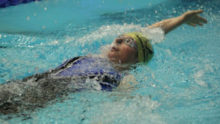
To buy a wetsuit, or not to buy a wetsuit? That is the question!
February 17, 2017Swim England Masters and Open Water Officer Sharon Lock answers your questions around the new FINA wetsuit rules.
Looking forward to your favourite lake opening
As you all start to hope the weather is warming up and the nights are getting lighter there may be a little spark igniting in you that is looking forward to your favourite lake opening.
For those hardy and brave enough, to have kept swimming through winter we are all in awe of your dedication. But this year for the competitive open water swimmers out there you may have heard FINA have changed the rules about competing in wetsuits.
I have been asked quite a few questions about these rules and understand it will have many different effects.
Some of you may be enthused and may even consider your first ASA open water event. Others will be disappointed because they don’t want to be ‘made to wear a wetsuit’.
Mainly people want to know if they need to buy a wetsuit and if they can use the ones they already have.
FINA’s research into swimming in low temperatures
FINA conducted research into swimming in lower temperatures and have used this as guidance to devise the rules around when to wear a wetsuit and what defines a wetsuit.
Basically, in all ASA open water events (not any events organised by other organisations in this country) you will need to comply with the following:
- Water temperature of 20o and above: no wetsuit.
- Water temperature between 18 and 19.9o: swimmer can choose to wear a wetsuit or not.
- Water temperature between 16 and 17.9o: wetsuits are compulsory.
- Water temperature below 15.9o: swimmers should not be competing.
How do I know which suit is legal?
The next question people have asked is: “There are lots of wetsuits. How do I know which ones are legal?”
The rules state a wetsuit is made of material providing thermal insulation, shall completely cover torso, back, shoulders and knees. They shall not extend past neck, wrists and ankles.
They should be between 3mm and 5mm thickness but can be lower in some parts of the suit to allow free movement. This means the main purpose of the suit is to keep you warm and short or sleeveless wetsuits will not be allowed.
If you are a serious open water swimmer, then you will probably already have one. Check the rules to make sure yours complies and if it does, great! Carry on using it.
If not, you may like to think about buying a new one. If you haven’t got one and are thinking about taking this discipline up then it would always be beneficial.
Having a wetsuit can make open water training more pleasant. It allows you to get used to wearing one and you’ll be able to train in open water that little bit earlier and later in the year. You will also be prepared if the water temperature is low on the day of your race.
However, there are alternatives. You can hire one online or from a lot of suppliers but my best advice is to talk to other people and try lots of different suits until you find the one that fits you well.
Look out for more information on the Open Water Festival on 30 and 31 July at Rother Valley or check your regions ASA website for details of your Regional Champiobnships.
 Masters Swimming Hub
Masters Swimming Hub





